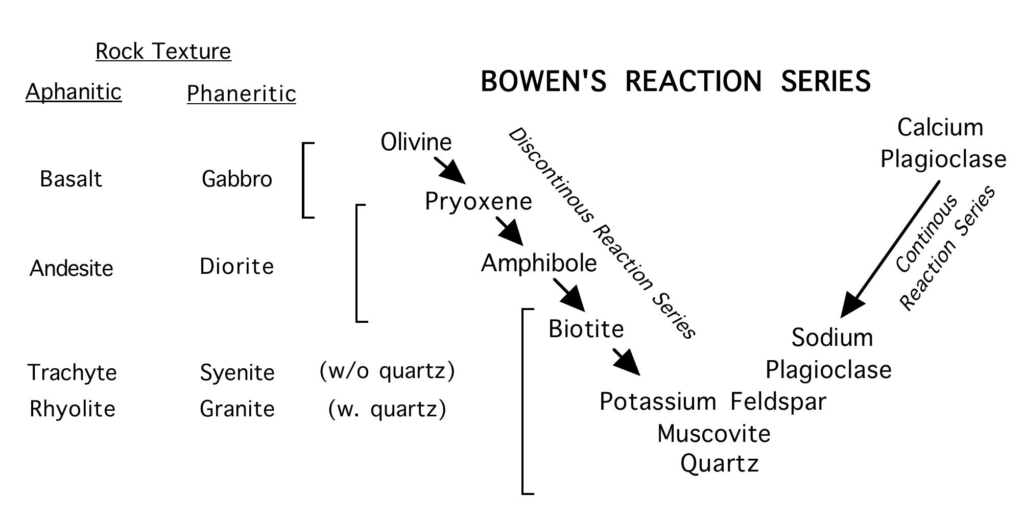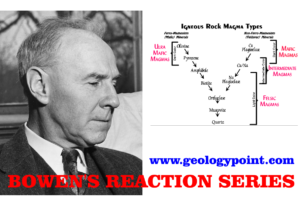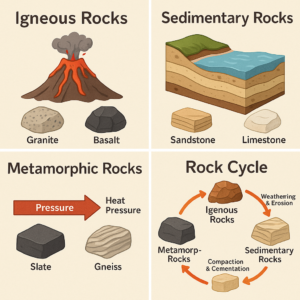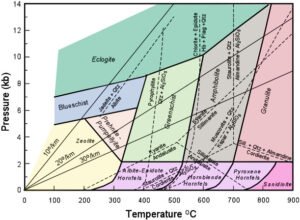Introduction
Bowen’s Reaction Series explains how rocks form from magma with different mineralogical composition. This crystallization sequence, which was first put forth by Norman L. Bowen in the early 1900s, aids geologists in comprehending how various minerals form at various temperatures as molten rock cools. Bowen’s work, which combined temperature, crystallization order, and mineral chemistry into a single, potent figure, radically altered our understanding of igneous rocks. But it reveals the story of Earth’s dynamic inner workings, going beyond the textbook picture.
Who was Bowen?
Norman Levi Bowen was a Canadian geologist and petrologist working at the Carnegie Institution in the early 1900s. Through experimental petrology, Bowen melted and cooled rock-forming minerals in a lab to observe how they crystallized. What he found was revolutionary: minerals don’t crystallize all at once. Instead, they form in a specific sequential pattern based on temperature, pressure, and composition. The reason granite is abundant in quartz and feldspar, and basalt is rich in pyroxene and plagioclase, was made clearer by Bowen’s Reaction Series. It gave igneous differentiation, the process by which a single magma can give rise to multiple forms of rock, a scientific foundation.
The Reaction Series
Bowen’s Reaction Series is often represented as a Y-shaped diagram, branching into two key paths:
- The Discontinuous Series (left branch)
- The Continuous Series (right branch)
Each branch describes how different minerals crystallize at specific temperatures as magma cools from around 1200°C to 600°C.

1. The Discontinuous Series
On the left side, the discontinuous series refers to the crystallization of mafic (iron and magnesium-rich) minerals that form in a stepwise fashion, each mineral having a distinct crystal structure. Here’s the typical order:
- Olivine (high temperature)
- Pyroxene
- Amphibole
- Biotite mica (lower temperature)
Each of these minerals forms at a specific temperature. As magma cools, the earlier-formed mineral becomes unstable in the new conditions and reacts with the remaining melt to form the next mineral. That’s why it’s called “discontinuous”—each step represents a different crystal structure and mineral identity. For example, if olivine forms early but conditions change, it doesn’t stay put—it reacts with silica in the melt to form pyroxene.
2. The Continuous Series
On the right side, the continuous series features plagioclase feldspar, which evolves chemically but maintains a consistent crystal structure throughout cooling. Early-formed plagioclase is calcium-rich (anorthite), but as cooling progresses, it shifts toward sodium-rich (albite) composition. This change is gradual and “continuous”—meaning earlier-formed crystals can partially re-equilibrate with the magma as it cools. The end result? A spectrum of plagioclase compositions in a single rock, often visible under the microscope as zoning in feldspar crystals.
3. The Bottom of the Series: The Final Crystallization
At the lowest temperatures (around 600–700°C), the remaining magma is silica-rich and forms felsic minerals, including:
- Potash feldspar
- Muscovite mica
- Quartz
These are typically found in granite and other felsic rocks, which form last in the crystallization sequence. Their formation marks the end of Bowen’s Series and often represents the final stages of magma evolution.
Why is Bowen’s series important in geology?
Igneous Rock Classification:
Bowen’s Reaction Series directly correlates with the types of igneous rocks we observe. Rocks that cool quickly, like basalt, are rich in mafic minerals from the top of the series. Slower-cooling rocks like granite contain the low-temperature minerals at the bottom of the series.
Mineral Assemblages and Textures:
The sequence also explains why certain minerals are often found together (mineral assemblages). For instance, olivine and pyroxene are common in gabbro, while quartz, potassium feldspar, and muscovite are typical of granite. Knowing this helps geologists interpret rock origins and the conditions under which they formed.
Magmatic Differentiation and Layered Intrusions:
One of the most powerful implications of Bowen’s Series is its role in magmatic differentiation—the process by which one parent magma gives rise to multiple rock types. As certain minerals crystallize out, they remove elements from the melt, changing its composition. Over time, a mafic magma can evolve into a felsic one. This principle is seen in large layered mafic intrusions like the Bushveld Complex in South Africa, where minerals settle according to Bowen’s crystallization order, forming visible layers of olivine, pyroxene, and feldspar.
Modern Relevance
While Bowen’s original series has stood the test of time, modern geology recognizes that real magmas are more complex than simple lab melts. Factors like volatile content, pressure, magma mixing, and crustal contamination can all influence crystallization. Today, computer models and experimental petrology have refined our understanding, but Bowen’s framework still forms the foundation for igneous petrology courses worldwide. It’s often the first conceptual tool that young geologists use to make sense of rock formation.
Applications of Bowen’s Reaction Series (Detailed Paragraph Format)
Bowen’s Reaction Series has a wide range of applications in geology, particularly in understanding the origin, classification, and evolution of igneous rocks. One of its primary applications is in interpreting the crystallization sequence of minerals from magma. By studying the order in which minerals form as magma cools, geologists can deduce the temperature and pressure conditions at which various igneous rocks were generated. For instance, rocks like peridotite or basalt, which contain high-temperature minerals such as olivine and pyroxene, are understood to have crystallized from hotter, mafic magmas. In contrast, granitic rocks, rich in quartz, muscovite, and potassium feldspar, are associated with lower-temperature, felsic magmas. This understanding helps in classifying igneous rocks based on their mineral composition and silica content.
Furthermore, Bowen’s Reaction Series plays a crucial role in deciphering the process of magmatic differentiation, where early-formed minerals settle out of the magma, changing its composition over time. This explains how a single magma body can produce a range of rock types from mafic to felsic through fractional crystallization. The series also aids in identifying zoning patterns within igneous intrusions and in predicting the mineralogical changes that occur as magma evolves chemically. This is particularly useful in petrological studies where determining the history of magma chambers and volcanic systems is essential.
Another significant application of Bowen’s Reaction Series is in metamorphic petrology. While the series is originally formulated for igneous rocks, the stability of the minerals formed at high temperatures also gives clues about their behavior during metamorphism. For example, high-temperature minerals such as olivine and pyroxene are unstable under surface conditions and may alter to serpentine or amphibole, respectively, during hydrothermal alteration or regional metamorphism. Recognizing these transformations helps geologists in identifying the protoliths (original rocks) of metamorphic terrains and in reconstructing the thermal history of an area.
In economic geology, Bowen’s Series is employed to locate and interpret ore deposits associated with igneous processes. Minerals like chromite, magnetite, and ilmenite, which crystallize early from mafic magmas, often form economically significant layers in ultramafic intrusions. Understanding the sequence and environment of mineral formation allows geologists to pinpoint specific zones within a layered intrusion that are more likely to contain valuable ore bodies. This knowledge is especially valuable in exploration strategies for platinum group elements (PGE), nickel, and titanium.
Volcanologists also apply Bowen’s Reaction Series to comprehend magma evolution and volcanic behavior. The viscosity and explosiveness of lava depend heavily on its silica content and mineral composition, both of which are governed by the crystallization sequence outlined in Bowen’s model. Mafic magmas with minerals like olivine and pyroxene produce low-viscosity, effusive eruptions, whereas felsic magmas, dominated by quartz and feldspar, tend to be more viscous and explosive. This insight is crucial for assessing volcanic hazards and understanding the dynamics of eruption styles.
In engineering geology, the mineral content and texture of igneous rocks—both of which relate to Bowen’s Reaction Series—affect their mechanical strength, weathering resistance, and suitability as construction material. For instance, rocks with high olivine or pyroxene content may be strong initially but weather rapidly in humid environments, affecting their long-term durability in building foundations or road construction. Geologists and civil engineers use this information to select appropriate rock types for various projects, particularly in areas with challenging geological conditions.
FAQs on Bowen’s Reaction Series
1. What is Bowen’s Reaction Series?
Bowen’s Reaction Series is a conceptual model developed by geologist Norman L. Bowen to describe the sequence in which minerals crystallize from a cooling magma. It explains how different minerals form at different temperatures and why certain mineral assemblages occur together in igneous rocks.
2. What are the two branches of Bowen’s Reaction Series?
The series is divided into:
- Discontinuous series: Involves the formation of different minerals (e.g., olivine → pyroxene → amphibole → biotite) as magma cools, each replacing the previous one.
- Continuous series: Describes the gradual change in composition of plagioclase feldspar from calcium-rich to sodium-rich as cooling progresses.
3. Why is Bowen’s Reaction Series important in geology?It helps geologists understand:
- The crystallization order of minerals
- Magmatic differentiation and rock formation
- Mineral stability and weathering trends
- Relationships between mineral assemblages and temperature conditions
4. What is the significance of the discontinuous reaction series?
The discontinuous series shows how one mineral transforms into another with a different structure and composition during cooling. This reaction pathway reflects changes in the chemical environment of the magma and helps explain the mineralogy of mafic and intermediate rocks.
5. What does the continuous reaction series represent?
The continuous series involves plagioclase feldspar continuously changing from calcium-rich (anorthite) to sodium-rich (albite) compositions. It represents solid-solution behavior without a major change in mineral structure.
6. Which minerals crystallize first according to Bowen’s Reaction Series?
High-temperature minerals crystallize first. These include: Olivine and calcium-rich plagioclase at temperatures above ~1200°C. They are followed by pyroxene, amphibole, biotite, and eventually by K-feldspar, muscovite, and quartz at lower temperatures.
7. How does Bowen’s Reaction Series explain the formation of different igneous rocks?
The series shows how early-forming mafic minerals are removed from the melt, causing the remaining magma to become enriched in silica. This process leads to the formation of different igneous rock types—from ultramafic and mafic to intermediate and felsic rocks—based on the minerals that crystallize.
8. Can Bowen’s Reaction Series be applied to metamorphic rocks?
Indirectly, yes. Although it was designed for igneous rocks, Bowen’s Series helps in understanding the stability of minerals under varying temperature and pressure conditions. This aids in reconstructing the protolith and metamorphic history of rocks.
9. What role does Bowen’s Reaction Series play in economic geology?
The series helps geologists locate ore deposits associated with specific mineral assemblages in mafic and ultramafic rocks. For instance, chromite and magnetite, which crystallize early, are often found in layered mafic intrusions.
10. How does the series relate to volcanic eruptions?
The mineral content (hence the silica content and viscosity) of magma—derived from Bowen’s Series—influences eruption style. Mafic magmas are less viscous and erupt quietly, while felsic magmas are more viscous and explosive.
11. Does weathering follow Bowen’s Reaction Series?
Yes, generally in reverse order. Minerals that crystallize at high temperatures (like olivine and pyroxene) are less stable at Earth’s surface and weather quickly, while low-temperature minerals (like quartz) are more stable and resistant to weathering.
12. Who was Norman L. Bowen?
Norman Levi Bowen was a Canadian geologist and petrologist who pioneered experimental petrology. His work in the early 20th century led to the formulation of Bowen’s Reaction Series, which remains fundamental in understanding igneous processes.






very good publish, i definitely love this website, carry on it
As I website owner I conceive the subject material here is really great, thanks for your efforts.
wohh exactly what I was searching for, thanks for posting.